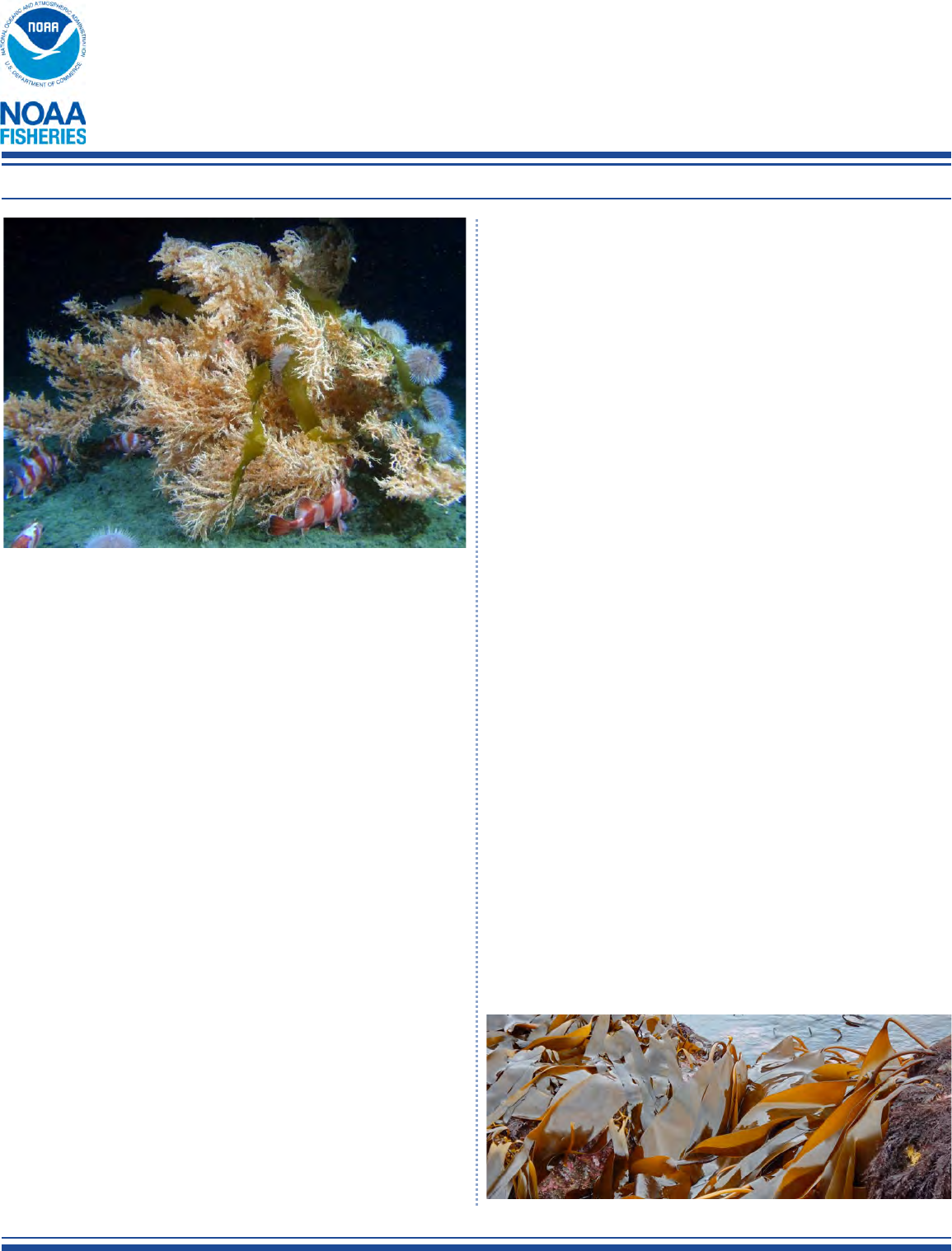
Fiscal Year 2022
Rockfish and sea urchins congregate around a large red tree coral
(Primnoa pacifica) in the Gulf of Alaska. Photo Credit: NOAA Fisheries
Table of Contents
Our Mission ………………………………………………………….. 1
HCD Accomplishments by the Numbers ………………. 2
A Message from ARA HCD ……………………………………. 2
HCD Sta ………………………………………………………………. 3
Accomplishments by Goal ……………………………………. 4
Goal 1 ……………………………………………………….. 4
Goal 2 ……………………………………………………….. 5
Goal 3 ……………………………………………………….. 7
Goal 4 ……………………………………………………….. 8
Goal 5 ……………………………………………………….. 10
Goal 6 ……………………………………………………….. 11
Publicaons, Presentaons and Outreach ……………. 12
Publicaons ………………………………………………. 12
Presentaons ……………………………………………. 13
Posters ……………………………………………………... 13
Trainings & Workshops……………………………… 13
Sean Eagan Parng Thoughts ……………………………….. 13
1
Our Mission
Habitat conservaon, protecon, and restoraon are
the foundaon for sustaining the naon’s sheries. The
Alaska Region (AKR) Habitat Conservaon Division (HCD)
carries out the Naonal Marine Fisheries Service’s
(NMFS) statutory responsibilies for habitat conserva-
on in Alaska under the Magnuson-Stevens Fishery Con-
servaon and Management Act (MSA), the Fish and
Wildlife Coordinaon Act (FWCA), the Naonal Environ-
mental Policy Act (NEPA), the Federal Power Act (FPA),
and other laws.
To priorize our resources and acvies, make decisions
in an ecosystem context, and strengthen the science
behind our decision-making, HCD works closely with the
Alaska Fisheries Science Center (AFSC), other Naonal
Oceanic and Atmospheric Administraon (NOAA) line
oces, the North Pacic Fishery Management Council
(NPFMC/Council), other federal and state agencies, non-
governmental organizaons, local governments, and a
variety of industry and conservaon groups.
The Alaska Region’s mission is science-based steward-
ship of living marine resources and their habitat in the
waters of the North Pacic and Arcc Oceans o Alaska.
Responsibilies include supporng sustainable sheries,
recovering and conserving protected species, and pro-
mong healthy ecosystems and resilient coastal com-
munies.
Kelps, Alaska Peninsula. Photo Credit: NOAA Fisheries
Accomplishments Report
Alaska Region’s Habitat Conservation Division
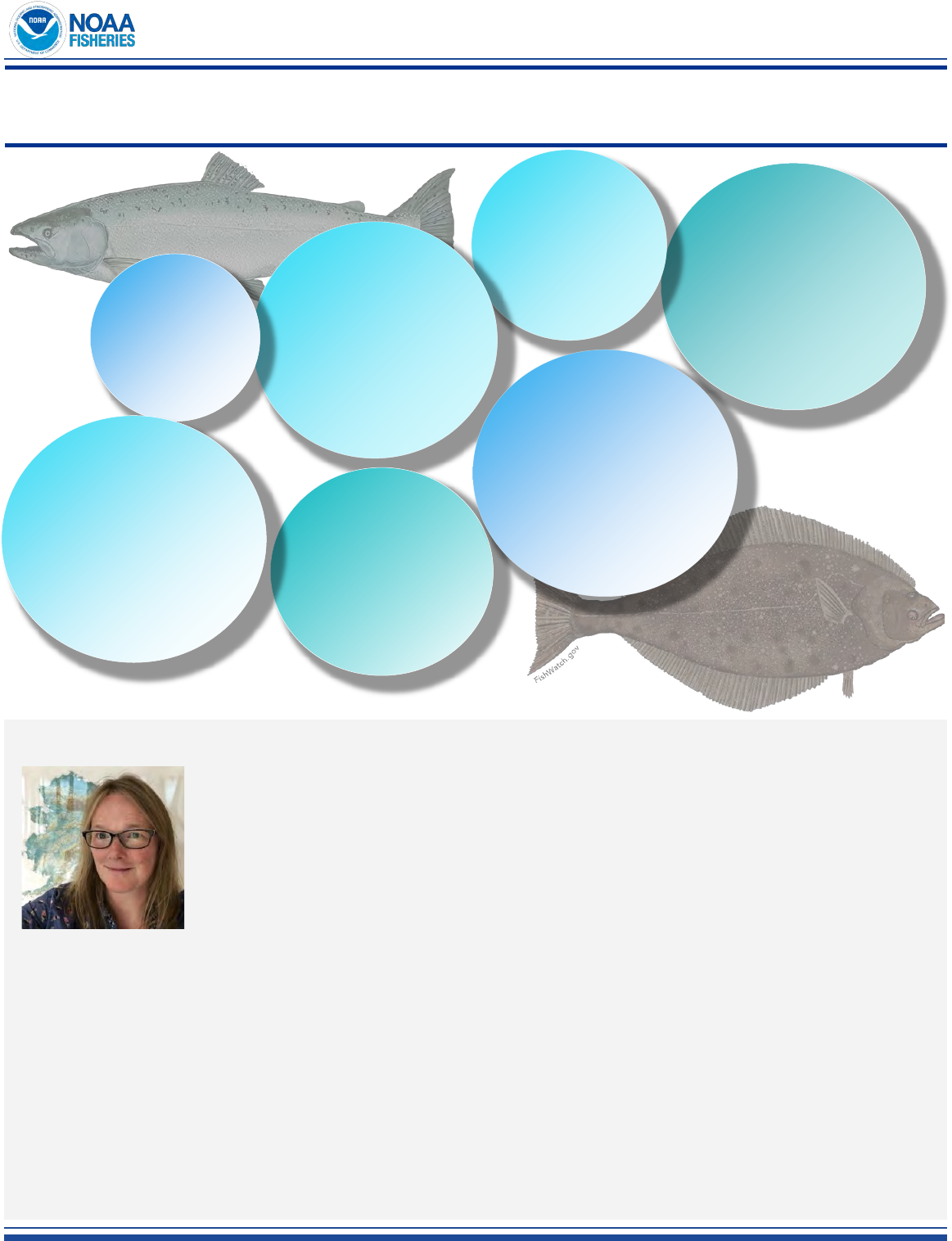
Accomplishments Report // Fiscal Year 2022
Summary of 2022: By the Numbers
> $ 7
Million
Funded 120 projects from
2006-2022
50
Early Coordinaon
consultaons
conducted
> $5
Million
Funding awarded
for Fish Passage
projects in AK
32
Completed EFH
Consultaons
57%
% EFH consultaons
Improved by HCD
recommendaons
$327,375
Funded 4 research
projects addressing
management and
science needs
~$4.5
Billion
Average wholesale value
of Alaska sh landings
per year
2
A Message from Gretchen Harrington, ARA HCD
The Habitat Conservaon Division’s acvies support NOAA Fisheries' mission for the
stewardship of the naon's ocean resources and their habitat. We provide vital services
for the naon, all backed by sound science and an ecosystem-based approach to manage-
ment. In support of this mission, our team implements several federal laws: the Mag-
nuson-Stevens Fishery Conservaon and Management Act, the Fish and Wildlife Coordi-
naon Act, and the Federal Power Act, established to conserve Alaska's marine and fresh-
water sh habitats. Our eorts through these mandates support culturally and economically important sheries.
Aer all, healthy habitats support healthy sheries. Our sta bring diverse and valuable skills to the region to sup-
port the agency’s mission and our goals. This accomplishments report highlights the good work we completed in
FY22, the diversity of acvies, and the collaboraons that support our goals. This is, however, just a glimpse into
our work. In reality, a great deal more eort and dedicaon and collaboraon with partners goes into aaining our
goals. This was also a year of change. We said hello to one new sta member, Skylar Bayer, and said farewell to sev-
eral others. With these changes comes new opportunies, new perspecves, and new direcons. Those changes will
undoubtedly inuence our approach to achieving our goals. Enjoy reading about our work and seeing how we are
changing, and that it inspires you to learn more.
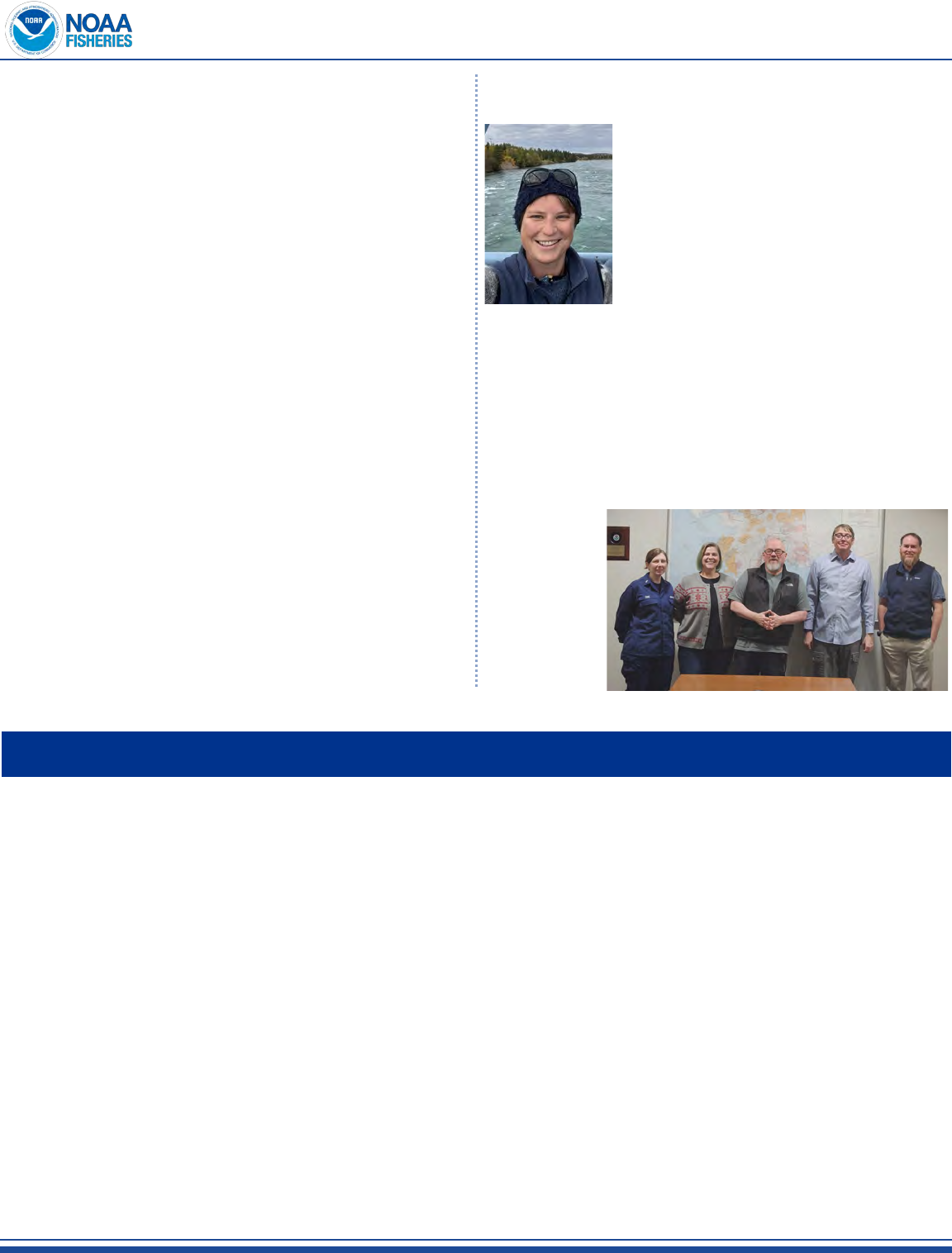
Accomplishments Report // Fiscal Year 2022
The 2022 HCD Team
Erika Ammann, Fisheries Biologist, NMFS Restoraon
Center
Cheryl Barnes, Ph.D., Postdoctoral Research Associate
Skylar Bayer, Ph.D., Resource Management Specialist
Ashley Bolwerk, Alaska Sea Grant State Fellow
LTJG Stefanie Coxe, Resource Specialist
Sean Eagan, Hydropower Coordinator
Charlene Felkley, Essenal Fish Habitat Coordinator
Bill Hines, Marine Resource Specialist
Seanbob Kelly, Fisheries Biologist
Barb Lake, Administrave Assistant
Doug Limpinsel, Fisheries Biologist
Joshua Markwell, Administrave Assistant
Sean McDermo, Supervisory Marine Habitat
Resource Specialist
John Olson, Fisheries Biologist
Jodi Pirtle, Ph.D., Juneau Branch Chief & Deputy Assis-
tant Regional Administrator
Linda Shaw, Wildlife Biologist
Ellen Ward, Ph.D., Resource Management Specialist
Molly Zaleski, Resource Management Specialist
Welcome Aboard!
Dr Skylar Bayer joined HCD in Septem-
ber. Skylar is a marine ecologist with ex-
perse in shellsh populaon dynamics,
aquaculture, science communicaon, and
policy. Skylar is joining us from Roger Wil-
liams University where she was the facul-
ty supervisor of the Shellsh Program and
in 2021 as a Fulbright Scholar studied Ice-
landic scallops and their shery in Iceland. Prior to that she
was a postdoctoral research associate with NOAA Fisheries
Milford Lab and a Knauss Marine Policy Fellow in 2018. Skylar
has a PhD in Marine Biology from the University of Maine, an
MS in Biological Oceanography from MIT/Woods Hole Joint
Program, and a BS in Marine Biology from Brown University.
HCD Anchorage
Staff.
Photo credit:
Michael Williams
Dr. Cheryl Barnes has a new posion at the AFSC in the Gulf
of Alaska Climate Integrated Modeling Project (GOA-CLIM).
Cheryl was a postdoctoral research associate with HCD since
January 2020, where she developed temporally dynamic spe-
cies distribuon models (SDMs) to integrate climate change
consideraons in EFH mapping for North Pacic species.
Ashley Bolwerk completed her year-long Sea Grant Fellow-
ship with HCD. Ashley formed a pinto abalone working group
and conducted a survey of atudes about management of
this species in Southeast Alaska communies. Ashley is mov-
ing on to a subsistence resources posion with the US Forest
Service (USFS) in Sitka. We are so appreciave of the me we
had with Ashley and wish her well.
Sean Eagan is now working with the Naonal Park Service
at Glacier Bay Naonal Park. Much of Sean’s federal career
has been with the Park Service, including American Samoa.
Sean joined HCD in 2015 as a hydrologist supporng the hy-
dropower review program.
Joshua Markwell moved on to train for a new career in safe-
ty management. Joshua joined HCD as an administrave as-
sistant in May 2021 aer leaving the U.S. Air Force. His me
here was short but we enjoyed geng to know him.
Dr. Jennifer Marsh is connuing her research on Arcc sh
communies with the University of Alaska Fairbanks. Jen was
a postdoctoral research associate with HCD since January
2020, where she developed Arcc species SDMs to support
EFH mapping for the 2023 5-year Review.
John Olson is now working with the Army Corps of Engi-
neers Civil Works program. John joined HCD in 2000 working
primarily on EFH consultaons and shing eects assess-
ment.
Dr. Ellen Ward has moved to NOAA’s Oce of Internaonal
Aairs in Washington, DC. Ellen joined HCD in June 2020
working on EFH consultaons, climate acon and sh habitat
partnerships. Notably, she studied muskrats as an ecohydro-
logic indicator species (e.g., muskrat in the wetlands).
3
Fair Winds and Following Seas …..
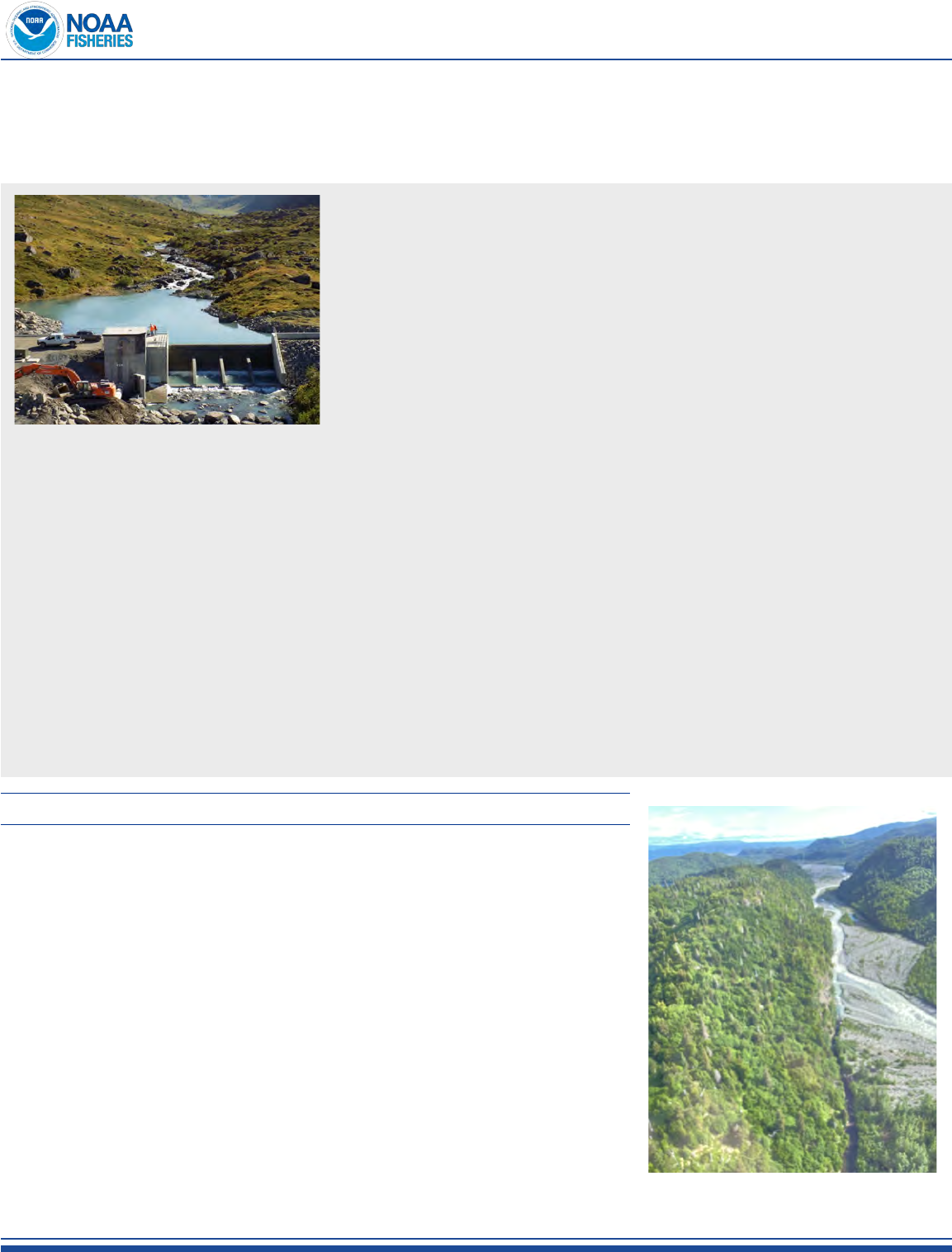
Accomplishments Report // Fiscal Year 2022
Goal #1
Identify and pursue opportunities to conserve and re-
store marine and anadromous water habitats.
Anadromous Fish Habitat and Renewable Energy
Anadromous shes provide a number of ecological funcons and values, func-
oning as prey in freshwater food webs and as important sources of marine de-
rived nutrients to freshwater and terrestrial habitats. Pacic salmon, as an exam-
ple, are signicant to commercial, recreaonal, and subsistence shing, and hold
signicant cultural value.
In Alaska, climate change is impacng the livelihoods and cultures of local com-
munies. The ability to reduce the state’s carbon footprint is crical. Hydropow-
er development provides a renewable energy alternave to diesel generaon for
many remote Alaskan communies. However, it may also aect the accessibility
of habitat for anadromous shes that support those communies. NOAA Fisher-
ies reviews and provides technical experse for many hydropower projects in
Alaska with the goal of protecng anadromous shes and their habitat while supporng the responsible development of hydro-
power generaon. Conserving and protecng diverse anadromous waters (ries and pools, sediment composion, groundwa-
ter seeps, etc.) supports species resilience as climate change increase water temperatures or alter ow paerns. One example
of successfully striking a balance between anadromous sh, their habitat and hydropower generaon is the Allison Creek Hy-
dropower Project in Valdez.
In 2016, Copper Valley Electric completed construcon of this run-of-river hydropower facility on Allison Creek, which is habitat
for coho and pink salmon. During licensing, HCD recommended run of river ow operaons, minimum ows in the bypass, and
screening to prevent false aracon at the tailrace to avoid adverse eects on salmon habitat. We also recommended moni-
toring of ow condions and sh populaons during operaons. Our involvement was also instrumental in designing a moni-
toring plan. The Project is a win-win as demonstrated by 10 years of monitoring of the salmon in Allison Creek. Valdez now has
6.7 megawas of renewable hydropower, allowing them to avoid burning 700,000 gallons of diesel annually, and the salmon
runs from 2016 to 2021 were similarly robust to the salmon runs before the project was constructed.
Allison Creek Hydroelectric Project in Valdez,
AK. Photo Credit: Copper Valley Electric
OTHER GOAL #1
Dixon Glacier Hydropower Amendment and Bradley Lake Hydroelectric Project:
The Bradley Lake Project (est. 1991) is the largest renewable energy project in Alas-
ka. Alaska Energy Authority (AEA) proposed a license amendment to the Bradley
Lake Project to capture water as the Dixon Glacier melts to support consistent pow-
er generaon. Half of Dixon Glacier is located within Kenai Naonal Wildlife Refuge
and Kenai Wilderness. AEA held an inial meeng in February 2022 to describe de-
sign opons. The glacial meltwater will be captured in a diversion basin and either
piped one mile downhill to a new power staon on Marn Stream, or ve miles
north to Bradley Lake reservoir. AEA ancipates generang an addional 55 mega-
was of power from the glacier water for a ten percent increase in Alaska’s hydro-
power capacity. Since the bypass reach is a narrow gorge that was under the glacier
a few years ago, the eects to sh habitat will be downstream. We ancipate as
much as seven miles of riverine habitat will be aected by the diversion. HCD pro-
vided study requests as part of the federal license amendment process to assess
potenal eects to salmon habitat for spawning, rearing, and migraon. Our in-
volvement inuenced the studies that will be completed and supported collabora-
on among the state and federal resource agencies.
Martin River valley, Kenai National Wildlife
Refuge. Photo Credit: Sean Eagan
4
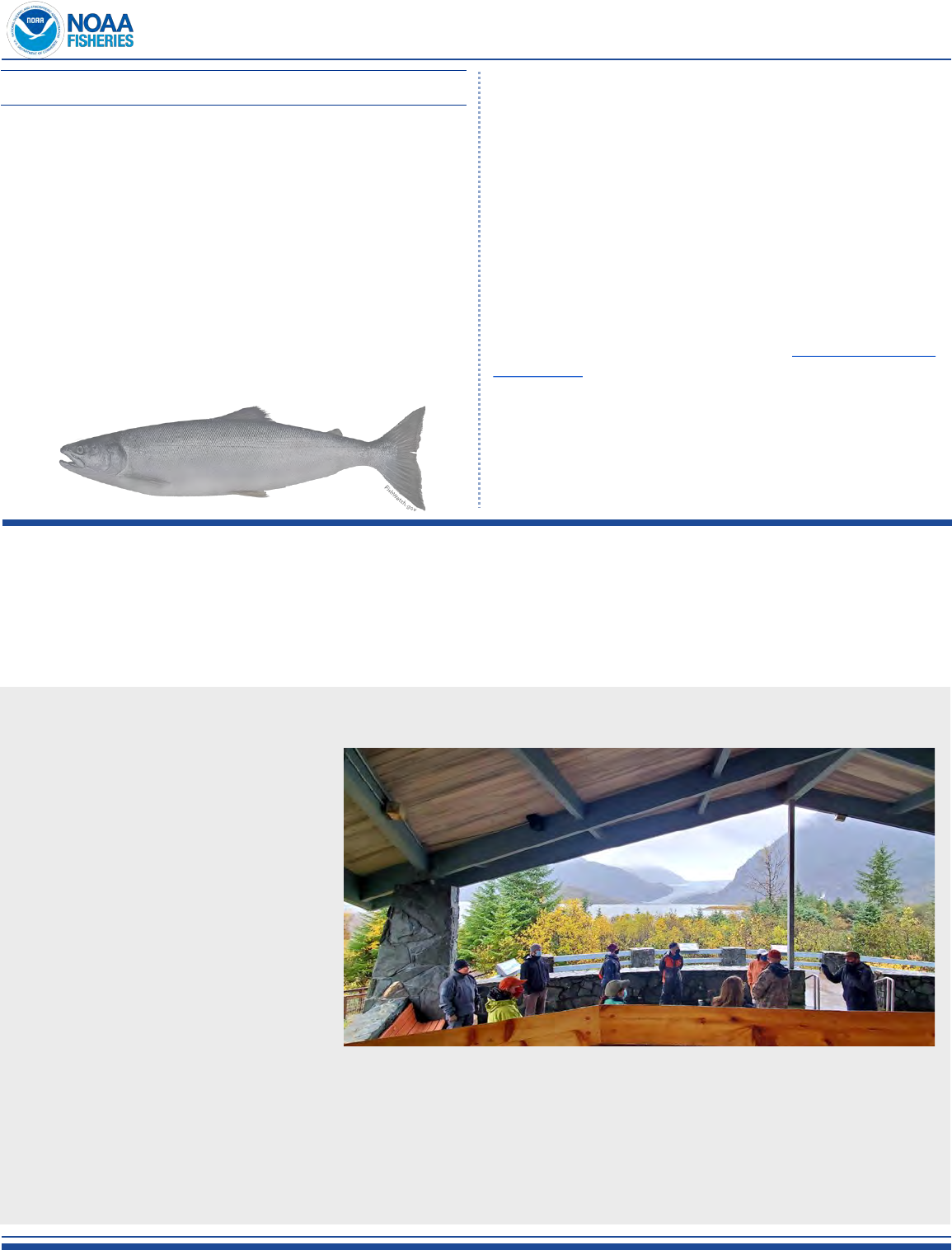
Accomplishments Report // Fiscal Year 2022
OTHER GOAL #1
Robe Lake Ecosystem Restoraon Project: Seanbob Kelly and Eri-
ka Ammann (NOAA Restoraon Center) met with state and federal
resource agencies, the USACE, and Nave Village of Tatlek repre-
sentaves to discuss the Robe Lake Ecosystem Restoraon Project
study process. This project is part of the USACE’s Secon 206 Eco-
system Restoraon program. The quanty and quality of Pacic
salmon habitat at Robe Lake has decreased signicantly since the
1950s when dikes were constructed to abate oods. The dikes re-
duced the inow of water to Robe Lake, resulng in increased wa-
ter temperatures, vegetave growth, and anoxic condions during
winter. The planning meeng provided an opportunity to dene
problems and idenfy objecves. HCD sta plans to remain in-
volved in this restoraon project.
Alaska Regional Response Team ARRT: Oil spills are a recognized
potenal stressor to marine life worldwide. Toxic components of oil
negavely impact EFH and the tness of marine animals. Seanbob
Kelly parcipates in the NOAA Fisheries Oil Spill Response Team by
coordinang with other Regional Divisions. During oil spill respons-
es and drills, HCD provides informaon on EFH and habitat areas of
parcular concern (HAPC) in a report known as the resources at
risk. The HCD team is present at the oil spill response and prepar-
edness meengs. These meengs are well aended by the public,
tribal governments, and state and federal agencies including the
U.S. Coast Guard, the Environmental Protecon Agency, and the
Alaska Department of Environmental Conservaon. During these
meengs we review the latest reports from across the state, dis-
cuss our accomplishments including the new Alaska Regional Con-
ngency Plan, and learn how to incorporate Indigenous Knowledge
into decision making. We also receive briengs from the Bureau of
Safety and Environmental Enforcement and U.S. Coast Guard Sec-
tor in Anchorage about the development of Response Informaon
for Oshore Oil Spills in our Area Conngency Plans.
Goal #2
Provide EFH conservation recommendations that
maximize mission-critical benefits for Federally
managed species and their habitats.
Mendenhall Glacier Visitor Facility Improvements Project
The USFS proposed a large-scale project
at the Mendenhall Glacier Visitor Center
at Juneau. As proposed, the project would
redirect Steep Creek, expand parking, and
ll wetlands to create new trails along the
lakeshore. New boat docks would be con-
structed and would allow motorized ves-
sels on Mendenhall Lake to accommodate
an expected increase of tourists and an
expected decrease of glacier views. Molly
Zaleski and Linda Shaw toured the
Mendenhall Glacier Visitor Center with
USFS sta and USACE representaves.
HCD sta also reviewed the USFS dra
EFH assessment and dra Environmental
Impact Statement (EIS). Our comments highlighted data gaps pernent to salmon EFH, outlined possible impacts to EFH from
the proposed acons, and oered conservaon recommendaon (CRs). Our recommendaons focused on the sockeye and co-
ho salmon EFH in the area. We also recommended that the USFS consider potenal adverse impacts of invasive vegetaon spe-
cies on aquac and riparian habitats in the watershed. Our input was well received and appreciated for improving the clarity
and transparency of the review process.
Representatives from HCD, the USFS, and the USACE discuss possible changes to the Menden-
hall Glacier Visitor Center and surrounding area (10/14/21). Photo Credit: Molly Zaleski
5
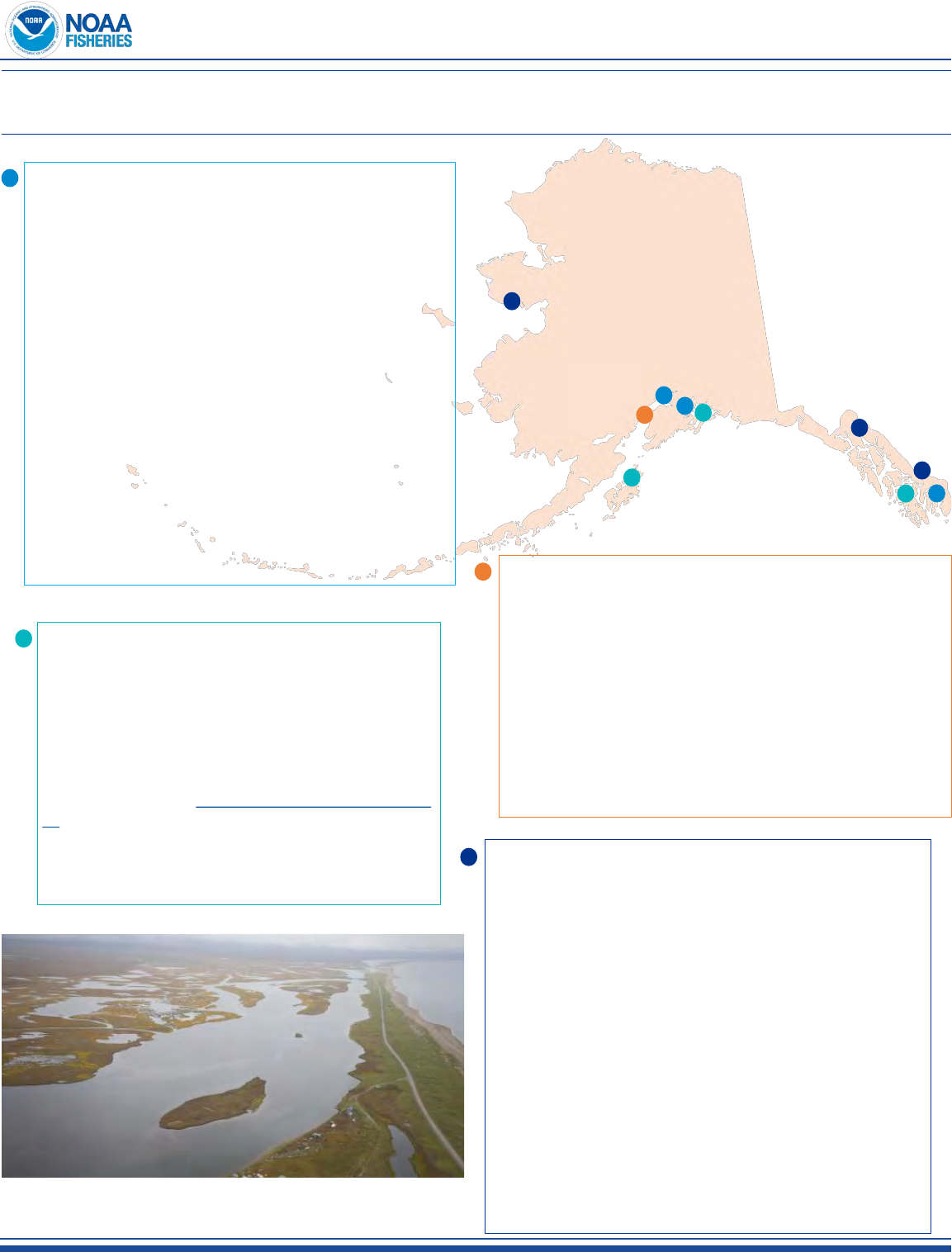
Accomplishments Report // Fiscal Year 2022
OTHER GOAL #2: Projects by Location: HCD engaged in early coordination and consultation on many proposed projects po-
tentially impacting EFH in 2022. We provide notable accomplishments from our non-fishing effects consultations in this section.
Transportaon Corridors: 1) Stefanie Coxe provided CRs for a
proposed Whier Cruise Terminal project. The purpose is to
perform a geotechnical survey to support designs for a cruise
ship docking facility. These CRs to protect salmon and sub-
merged aquac vegetaon are a connuaon of early coordi-
naon that started in July. 2) Seanbob Kelly met with PRD's
Port of Alaska Cargo Terminal project team to ensure any
CRs put forth or requirements will benet our trust resources
and not conict with each other. Proposed construcon may
begin in 2025 or 2026 and last 5 to 7 years. EFH assessment is
a long way out for the proposed project but early coordinaon
ensures best outcomes . 3) Seanbob Kelly completed the re-
view of the Tongass Highway Pavement Rehabilitaon Project
with a formal leer. The purpose is to enhance the safe move-
ment of vehicles, bicycle, and pedestrian trac by widening
the highway south of Ketchikan, Alaska, in the Tongass Nar-
rows. The project would ll 2.67 acres of EFH across approxi-
mately 4,000 linear feet of shoreline habitat currently impact-
ed by the exisng road. Proposed migaon would restore
sh access to an anadromous stream; thereby, restoring EFH.
Kelp and Oyster Aquaculture Farms: Molly Zaleski pro-
vided CRs to Alaska Department of Natural Resources
(ADNR) and the USACE for 15 proposed kelp, oyster, and/
or multrophic aquaculture farms. Most CRs were pro-
vided informally during early coordinaon with ADNR or
without needing an EFH assessment. Some formal leers
focused on the larger footprint created by perming mul-
tiple farms in a single bay. That concern was echoed by
USFS. In most CRs, the Alaska Aquaculture Permitting Por-
tal was highlighted as a useful tool for permit applicants.
They are in the planning process for potential future
farms, and we saw this as a useful way to be proactive
and front-load the consultation process.
BOEM: 1) Doug Limpinsel and Jill Seymour (Protected Resources
Division or PRD) provided comments to NOAA Headquarters on
the Bureau of Ocean Energy Managements (BOEM), 2023-2028
Naonal Outer Connental Shelf Oil and Gas Leasing Program
report and the Naonal Programmac Dra EIS. They compiled
comments submied from regional subject maer experts from
AKR and AFSC to beer inform BOEM’s naonal process. 2) In a
separate exercise, Doug Limpinsel and Ellen Ward provided pre-
scoping comments regarding the Cook Inlet Lease Sale 258. HCD
recommended BOEM beer represent their greenhouse gas
emission’s analysis. BOEM and HCD plan to discuss improving
their understanding of the Cook Inlet marine ecology.
Mines: 1) IPOP proposed to mine for gold in the Bonanza Chan-
nel of Safety Sound near Nome. Total impacts from the ve-
year mining plan are dredging 195 acres and the disposal of ap-
proximately 4,827,161 cubic yards
of material. The proposed
mine included dredging and placing ll in wetlands and estuarine
nearshore environments. HCD provided concerns and CRs based
on best available science. In September, USACE denied the appli-
caon for a permit. 2) The USFS issued its record of decision to
raise Kensington Mine tailings dam by 36 feet to accommodate
10 more years of mine tailings storage. If this dam were to fail, a
signicantly larger area of sh habitat in Berners Bay will be cov-
ered in mine tailings compared to spillage at its current capacity.
We advocated for a dry stack tailings pile similar to Green’s
Creek Mine. 3) Transboundary Mining Interagency Working
Group: Molly Zaleski is the technical advisor on the proposed
Eskay Creek Mine in Brish Columbia. The largest risks are two
proposed tailings dams. If failure occurs, this would impact the
Unuk River. HCD highlighted the downstream and transbounda-
ry impacts to EFH from mining operaons in B.C.
Bonanza Channel at Safety Sound near Nome. Photo credit: The Nome
Nugget
6

Accomplishments Report // Fiscal Year 2022
OTHER GOAL #2: Department of Defense
US Navy training acvies in the Gulf of Alaska (GOA) 2023: Char-
lene Felkley reviewed the GOA SEIS/OEIS for an upcoming United
States Department of the Navy (U.S. Navy) training exercise, re-
ferred to as Northern Edge (April to October 2023). Early coordina-
on with the U.S. Navy ensured that the MSA regulatory require-
ments were met and potenal adverse impacts to EFH were mini-
mized. The U.S. Navy provided extensive habitat-related infor-
maon within the consultaon analysis and new, is a large miga-
on area (see map) that covers the connental shelf and slope out
to 4,000 meters depth with the purpose of minimizing adverse im-
pacts to salmon and their migraon routes.
Arcc Research Acvies in the Beaufort and Chukchi Seas 2022-
2025: Charlene Felkley consulted on an Oce of Naval Research
project to be conducted September 2022 to 2025. The purpose of
this project is to conduct Arcc Research Acvies in the Beaufort
and Chukchi Seas to test the feasibility of using a eld of acve
acousc sources as navigaon aids to unmanned vehicles collecng
oceanographic and ice data under ice-covered condions. Acvies
in the Arcc include gliders, research vessel acvies, moored and
driing sources, and on-ice measurement systems.
The USACE was asked by the Village of Solomon to con-
duct baseline sh and wildlife surveys in the surrounding
wetlands of Nome, Alaska. To enhance USACE’s project,
HCD proposed eDNA as a sampling method. In response
to USACE interest in seng up a rural eDNA pilot project,
HCD coordinated a team composed of AFSC sciensts,
USACE, and local stakeholder members to collect eDNA
data for nearshore sh near Solomon and Akun. USACE
has collected eDNA from two locaons in rural Alaska,
several mes during the summer and fall eld seasons.
Results are expected in 2023. Results and methods of
these projects will be a template for future nearshore
eDNA research collaboraons with the USACE in Alaska.
HCD sta collaborated with the Chilkoot Indian Associa-
on's regional monitoring project where water samples
were collected in the Chilkoot River for environmental
DNA (eDNA) analysis to track eulachon run ming.
HCD published a web story to demonstrate how eDNA
metabarcoding can be used to characterize nearshore sh
communies in a high-latude marine environment. These
ecosystems are inuenced by large dal swings, strong cur-
rents, and signicant freshwater input from large rivers, rain,
and snowmelt.
All organisms shed DNA into the environment. Environmental DNA (eDNA)
can be used to determine the identities of the fish species that are present at
or near the time of sample collection. Photo Credit: NOAA Fisheries
Goal #3
Use the best available science to
conduct EFH reviews and consul-
tations that support sustainable
fisheries, healthy marine
ecosystems, and resilient coastal
communities.
eDNA Pilot Projects
In 2022, HCD encouraged the use of environmental DNA
(eDNA) and NOAA Fisheries’ experse in this area to support
pilot projects applying this method in Alaska. Moreover,
eDNA data can be used to ground truth our EFH maps in data
-poor areas that depend on model predicons and lack sur-
vey or sampling informaon.
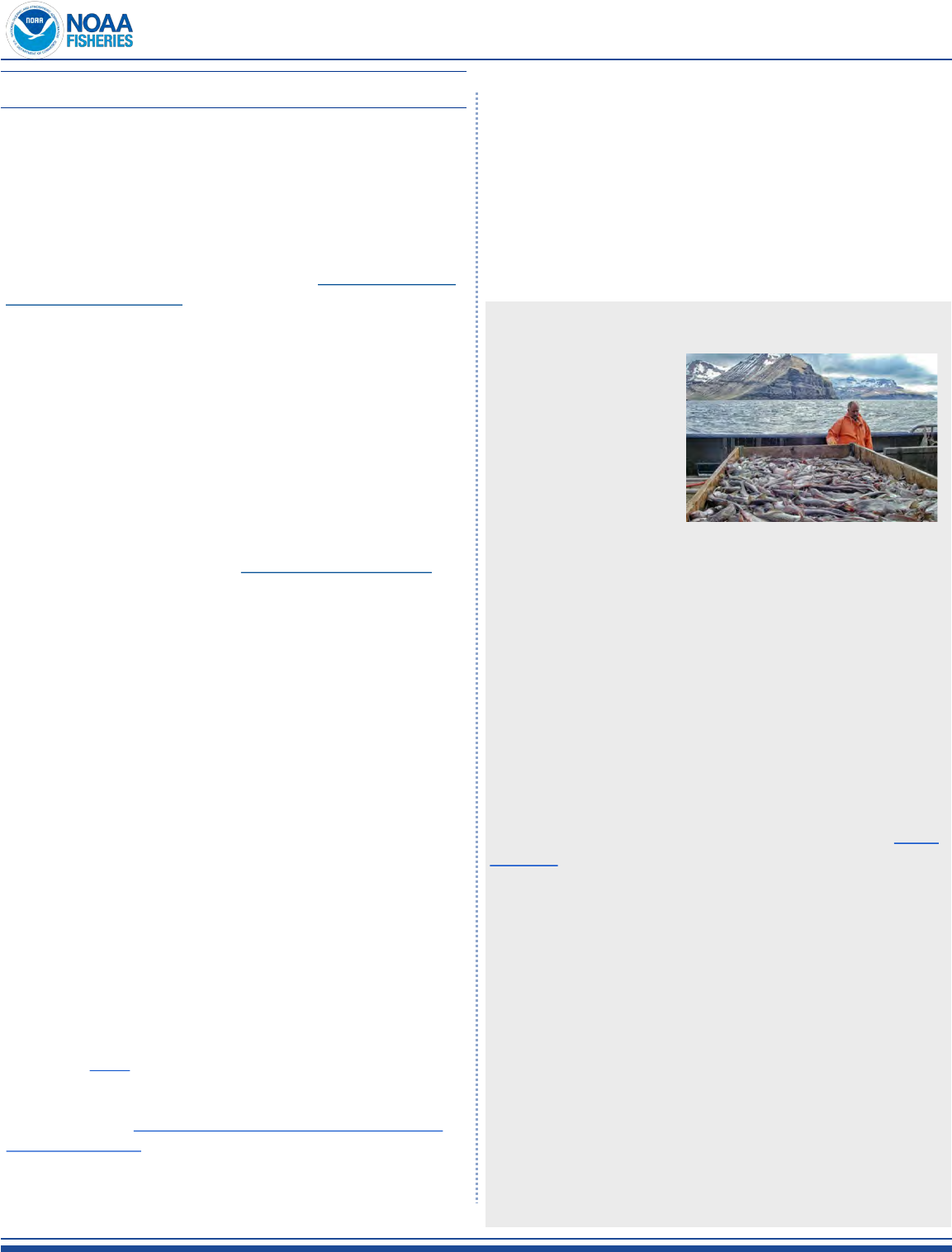
Accomplishments Report // Fiscal Year 2022
OTHER GOAL #3: Increasing Information Accessibility
New HCD Leers Database: Ten HCD sta nished entering over
1,200 leers from the last 22 years into our internal database. Sta
can now extract and query leers in mulple ways including by top-
ic, date, author, or state/federal tracking number. Special acknowl-
edgement to Linda Shaw, an excellent leer writer, who has wrien
more leers with EFH CRs than any other living person in Alaska.
Nearshore Fish Atlas of Alaska Database: The Nearshore Fish Atlas
of Alaska (NFAA) database was updated in FY21 to include a 5-fold
increase in data holdings, including addional gear types, locaons,
and surveys from many contributors. In June 2022, HCD and AFSC
sta updated the NFAA database website with user funcon and
accessibility improvements such as new and streamlined query
tools and results export, ability to download the whole database,
and user guide. Darcie Ne and Mandy Lindeberg (AFSC Auke Bay
Labs) walked us through the new website to get nearshore species
and habitat informaon to inform EFH consultaons and other Eco-
system-based sheries management (EBFM) informaon needs.
The project to update the NFAA data holdings and website was
funded by the Alaska EFH Research Plan.
Provide habitat expertise based
on the best available science to
improve habitat conservation and
facilitate EBFM.
Goal #4
Ecosystem-based Fishery Management
(EBFM)
HCD coordinates and
shares habitat infor-
maon with EBFM acvi-
es as an ongoing ele-
ment of our work.
Through these acvies
we have integrated ap-
plied habitat science in
EBFM to enhance NMFS mission eecveness, including de-
veloping an on-ramp to integrate habitat informaon into
stock assessments (e.g., Shotwell et al. 2022), and dynamic
species distribuon modeling methods to idenfy climate
change eects on EFH and spaal stock structure with a case-
study in the Bering Sea (e.g., Barnes et al. 2022). Addional
work to develop and support direct communicaon pathways
from habitat science conducted to management implement-
ed is an ongoing priority for HCD and NMFS AKR.
Jodi Pirtle is on the NOAA Fisheries EBFM Working Group and
AKR EBFM Team with regional oce and AFSC sta. In 2021
the EBFM Working Group published a NOAA Technical Mem-
orandum that idened ways to integrate Ecosystem Status
Reports with achieving other EBFM milestones that improve
connecons with shery management pracces.
The NPFMC hosted the 7th naonal meeng of the Scienc
Coordinaon Subcommiee (SCS7) in Sitka, Alaska. The
meeng addressed challenging and mely shery manage-
ment issues and was well aended by SSC delegates and sta
from all eight Regional Fishery Management Council SSCs, as
well as NMFS Headquarters. Jodi aended and parcipated in
work sessions over the three day meeng. The SCS7 focused
eorts on developing recommendaons for the following
topics: How to incorporate ecosystem indicators into the
stock assessment process, Developing informaon to support
management of interacng species in consideraon of EBFM,
and How to assess and develop shing level recommenda-
ons for species exhibing distribuonal changes.
Alaska EFH Mapper Upgrade: The Alaska EFH Mapper website
that was launched in 2019 has received an upgrade. The work in
2022 by Informaon Services Division and HCD improved user func-
on and accessibility. Upgrades will allow the new Alaska EFH maps
to be installed following the 2023 EFH 5-year Review. HCD in-
formed user-need improvements before project launch and during
a beta tesng phase. We look forward to the updated website
launching in early 2023 and sharing this with our partner agencies!
Fisheries Informaon System Proposal Funded: Improving the
management, security, and accessibility of HCD's spaal data as-
sets, including nearshore sh habitat and EFH datasets, is a priority
under our strategic divisional goals. HCD submied a proposal to
the Fisheries Informaon System FY23 request for proposals to
work with a cross-divisional team within AKR and AFSC to 1) imple-
ment a data archival pathway for our spaal data assets with the
Naonal Centers for Environmental Informaon (NCEI), and 2)
build a new and internally managed NMFS Alaska Nearshore Data
Portal from exisng and growing datasets - ShoreZone, Shore Sta-
on, and Nearshore Fish Atlas - and plan for future integraon of
new datasets. This work is supported in part by AKRO discreonary
funding and work will begin in early 2023.
Alaska Coastal Mapping Strategy: The Alaska Mapping Execuve
Commiee (AMEC) coordinates the modernizaon of crical geo-
spaal data and mapping products for Alaska with parcipants
from 15 Federal agencies. AMEC's Coastal Mapping Subcommiee
has developed the Alaska Coastal Mapping Strategy Implementa-
on Plan 2020-2030. This plan outlines a 10-year strategy for map-
ping the coast of Alaska in support of the US economy, security,
and environment. In 2022, the subcommiee included Ellen Ward
and Jodi Pirtle.
Fishing for groundfish, Alaska. Photo
Credit: Molly Zaleski
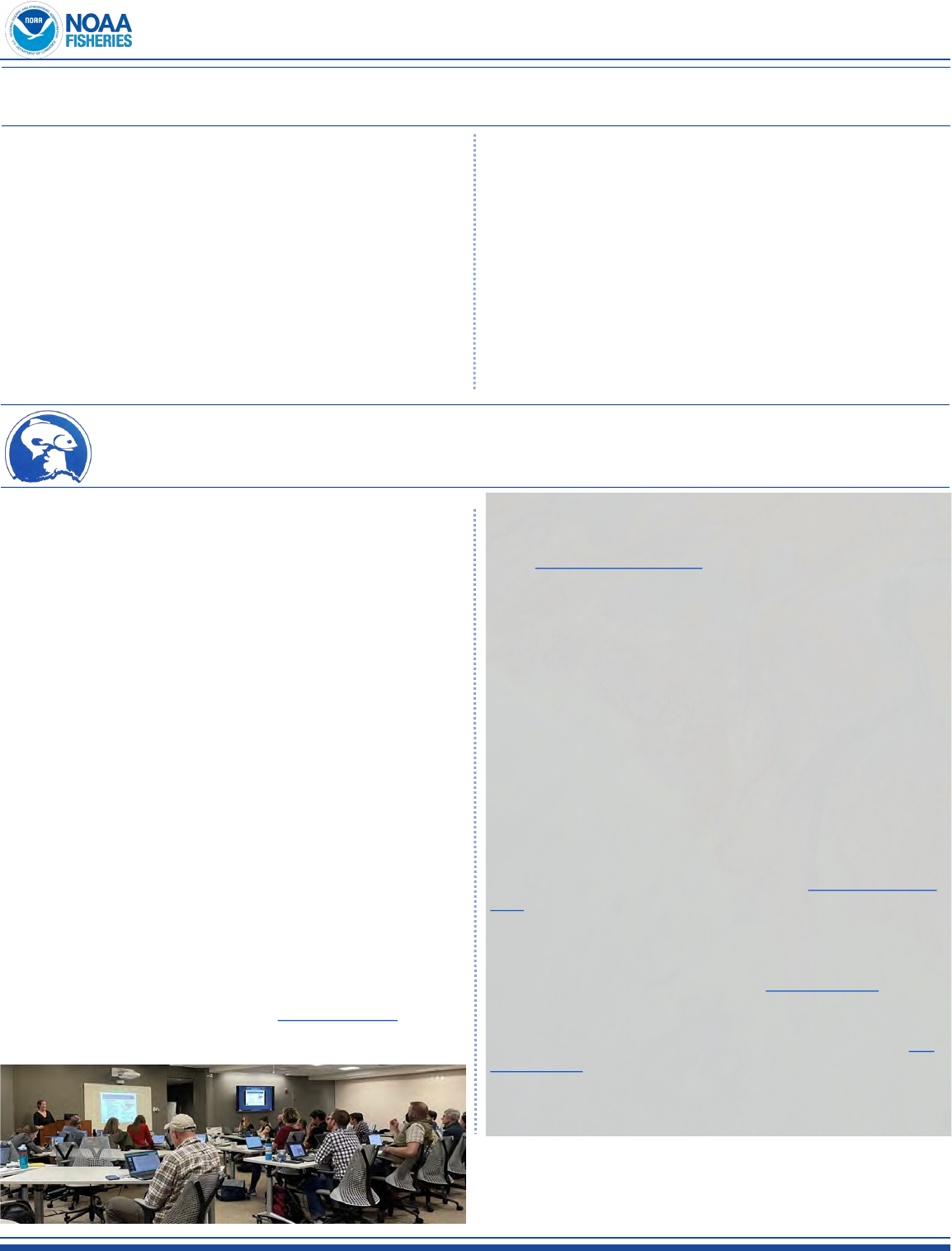
Accomplishments Report // Fiscal Year 2022
9
OTHER GOAL #4: Climate is a fundamental concern in assessing EFH. We have provided habitat expertise specifically in the
area of climate change in several different ways this year.
Cheryl Barnes, Jodi Pirtle and others invesgated climate-
informed SDMs in a Bering Sea groundsh case study. We de-
veloped and published SDMs with diering temporal scale and
variability and compared skill in hindcasng and forecasng
species distribuons. Jen Marsh, Jodi Pirtle, and others have
been developing SDMs and revised EFH maps for Arcc sh
and crab species for the current 5-year Review. The Arcc spe-
cies work examines interannual variability in the spaal distri-
buon of species’ EFH area and habitat-related vital rates as a
rst step to consider climate change eects on EFH. These ad-
vancements in habitat science inform good approaches in de-
tecng habitat-related species distribuon shis in a changing
ecosystem to support EFH conservaon and EBFM.
Ellen Ward was an important part of climate change work in
HCD this year, serving as an Agency Chapter Lead for NOAA on
the Alaska chapter, helping to dra the h Naonal Climate
Assessment (NCA5). Ellen Ward collaborated with Greater At-
lanc Regional Fisheries Oce to review a training she had
developed for the climate change poron of NOAA’s new Mi-
gaon Policy for Trust Resources. Ellen Ward also presented on
the topic of migang climate change impacts on EFH in Alaska
at the American Fisheries Society meeng. All of her eorts in
this arena are applied at the naonal level through the Naon-
al EFH Climate Policy.
OTHER GOAL #4: Over the last year, the HCD and AFSC teams were engaged in Council Committees and pre-
sented current progress on habitat science to the NPFMC, their Groundfish Plan Teams, the Crab Plan Team, Eco-
system Committee, and the Scientific and Statistical Committee.
Ecosystem Commiee Iniaves: Gretchen Harrington was on the
NPFMC’s Ecosystem Commiee and supported their FY22 focus
areas including the Bering Sea Fishery Ecosystem Plan Team; the
Local Knowledge, Tradional Knowledge, and Subsistence Task-
force; the Climate Change Task Force and other important ecosys-
tem-related iniaves. The Commiee developed recommenda-
ons for the Council to connue these iniaves, highlighng a
need to be inclusive and recepve to individual perspecves while
applying ecosystem/climate data to inform decisions.
Fishing Eects Evaluaon Launch: Stock assessment authors and
species experts evaluated results from the 2022 shing eects
model for groundsh and crab species with an FMP in the Gulf of
Alaska, Bering Sea, and Aleuan Islands. This process focused on
species with a greater than or equal to 10% reducon in their core
EFH area and/or species below minimum stock size thresholds,
which connued the SSC’s 2017 Review approach. The process was
presented to groundsh stock authors at the Fishing Eects Evalua-
on launch and to crab stock authors during the Crab Plan Team
(CPT) meeng. Molly Zaleski, Jodi Pirtle, Gretchen Harrington, Sa-
rah Rheinsmith (Council), and Sco Smeltz (Alaska Pacic Universi-
ty) played an important role in evaluang eects, answering ques-
ons and addressing concerns the stock authors and CPT had. Mol-
ly Zaleski and Sco Smeltz presented an evaluaon of the shing
eects results to the CPT and the Joint Groundsh Team, receiving
valuable feedback and preparing for the 2022 SSC meeng to in-
form the Council and share habitat experse.
Essential Fish Habitat 5-year Review
At the November 2021 meeng, Jodi Pirtle presented the iterave
review process for EFH component 1 (descripons and idenca-
on) and component 7 (prey of EFH species) with focus on the re-
cently completed stock assessment author review of current and
new informaon in development for these EFH components with
EFH analyst responses.
Molly Zaleski, Gretchen Harrington, and AFSC team members Ned
Laman, Jeremy Harris, and Jim Thorson supported the presentaon
and dra report of the stock assessment author review. Stock as-
sessment authors provided helpful input to strengthen this work, in
parcular for the EFH component 1 new ensemble species distribu-
on models and EFH maps. Their review furthered collaboraon
between stock assessment sciensts and EFH analysts developing
habitat science for species managed under an FMP.
Jodi Pirtle, Ned Laman (AFSC), and John Olson presented to the
Ecosystem Commiee meeng and to the SSC (January 31 - Febru-
ary 4). A team from HCD and AFSC have developed 224 new and
revised EFH Level 1, 2, and 3 descripons and maps for 211 species'
life stages in three FMPs and the complete collecon of new EFH
component 1 informaon available for the 5-year Review was pre-
sented at these meengs (new EFH SDM Discussion Paper). The
shing eects evaluaon was also updated since the 2017 EFH 5-
year Review and a plan for addressing EFH component 2 Fishing
Eects was presented at this meeng (new EFH shing eects Dis-
cussion Paper).
The 2023 EFH 5-year Review process is ongoing with ancipated
compleon in 2023.
Molly Zaleski presenting the stock author fishing effects evaluation results to
the September Joint Groundfish Plan Teams meeting in Seattle, WA. Photo
Credit: Gretchen Harrington.
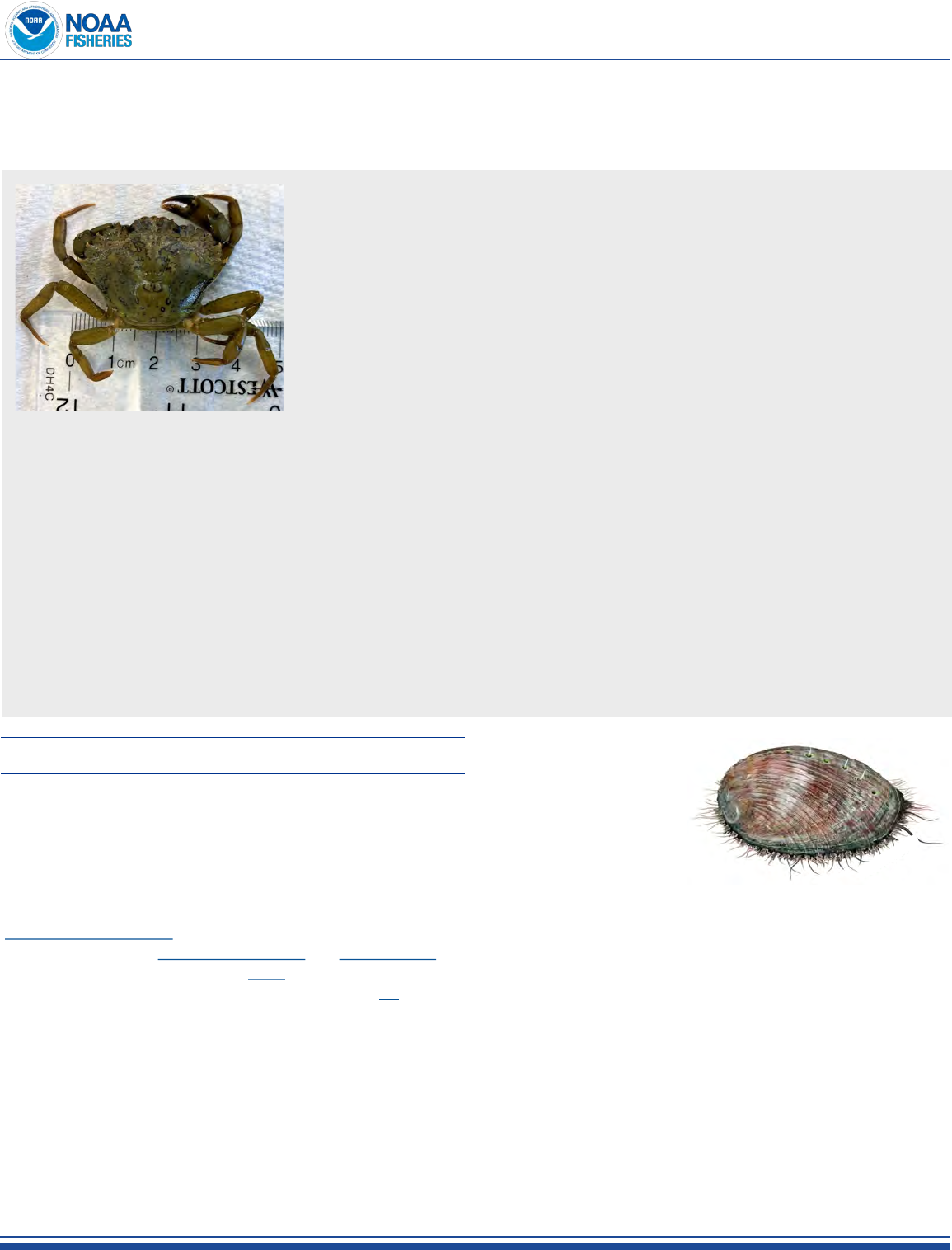
Accomplishments Report // Fiscal Year 2022
10
Goal #5
Participate in partnerships within and outside of
NOAA that advance habitat conservation.
Invasive Green Crab in Alaska
Linda Shaw, AKR Invasive Species Coordinator, and other HCD sta worked to prevent
the spread of invasive green crab in Alaska through shared stewardship and persever-
ance. Green crab has implicaons to NOAA trust resources, including predaon on ju-
venile salmon, compeon with juvenile Dungeness crab, and destrucon of eelgrass
beds. Brish Columbia and three western states reported increased populaons of this
invasive species at a Pacic States Marine Fisheries Commission West Coast Green
Crab Meeng in December 2021.
Prior to the crab’s arrival in Alaska, Linda Shaw collaborated on several grant proposals
to nd funding for early detecon eorts in southern Southeast Alaska. Shaw, along
with AKR’s graphic designer (Paul Irvin), and AKR’s Administrave Assistant (Barb Lake)
created a green crab idencaon outreach sign for posng at beaches in Alaska. The
team later worked with the Washington State University Extension Tribal Liaison and U.S. Department of Agriculture to custom-
ize the sign for the Metlakatla Indian Community (MIC) with local contact informaon. Alaska’s MIC Department of Fish and
Wildlife (DFW) provided baseline data in their 2021 report showing no green crab were caught by trapping. On July 19, 2022,
the rst evidence of the invasive green crab in Alaska was discovered by a team composed of folks from MIC-DFW, HCD, and
Sealaska Heritage Instute intern Natalie Benne during a carapace survey at Colby Creek Estuary on Annee Island. By De-
cember, the MIC-DFW had captured 750 live green crab in the estuary and outer shores of the island. MIC-DFW have connued
collecng eDNA samples for early detecon of invasive green crab elsewhere on the island, increased trapping eorts in the
estuary and outreach with community members. We recognize and support these eorts and promote the diversity and inclu-
sion goals of the AKR as these many collaboraons and partnerships have resulted in informaon sharing and ideas for future
eorts with plans to connue to work together on these ongoing invasion issues.
Invasive Green Crab. Photo Credit: Linda
Shaw
OTHER GOAL #5
Oil Spill Response and Preparedness Coordinaon: HCD parcipat-
ed in Arcc and Western Area Commiee Meeng and Industry
Day to discuss oil spill response and preparedness organizaon and
conngency planning alongside the Coast Guard, Federal agencies,
and industry. We also commented on the Arcc and Western, and
Prince William Sound dra Area Conngency Plans. Parcipang in
planning meengs is a good way to maintain our relaonship with
partners and allows our objecves to be built into projects.
Southeast Alaska Fish Habitat Partnership (SEAKFHP): NOAA part-
ners with SEAKFHP. Molly Zaleski and Erika Ammann regularly
aend their meengs. Topics covered monthly range from funding
opportunies, research updates, to new resources for coastal or
freshwater sh habitat informaon. Examples of the resources that
have been produced from this partnership include the updated
Conservaon Acon Plan to celebrate accomplishments and pre-
pare new goals, a new wetland mapping tool, the Seacoast Trust,
stream restoraon project updates (video), and a nod to the Na-
onal Fish Habitat Partnership's 2021 Waters To Watch list, which
includes Alaska's Jordan Creek and Eklutna River.
Department of Transportaon (DOT) EFH Coordinaon: Molly
Zaleski and Sean Eagan met with the Alaska DOT to review EFH As-
sessment informaon needs and a dra DOT template intended to
streamline the process and frontload ancipated EFH conservaon
recommendaons with project managers.
Abalone Working Group:
Sea Grant Fellow, Ashley
Bolwerk, led a meeng in
February, 2022, to form an
abalone working group in
Southeast Alaska. Several
organizaons joined to hear
about the goal and share
their interests. External
partners lead a discussion about eorts that used community en-
gagement to advance outreach and educaon, monitoring and con-
servaon of abalone. One method, abalone "condos", crab pots
lled with concrete blocks, were found to be used by both juvenile
abalone and rocksh. Ashley Bolwerk went to Hoonah and Prince of
Wales Island to conduct community outreach and connect with
tribal and community partners. This working group provides an
opportunity to exchange ideas for the future of abalone.
Pinto abalone. Image Credit: NOAA
Fisheries
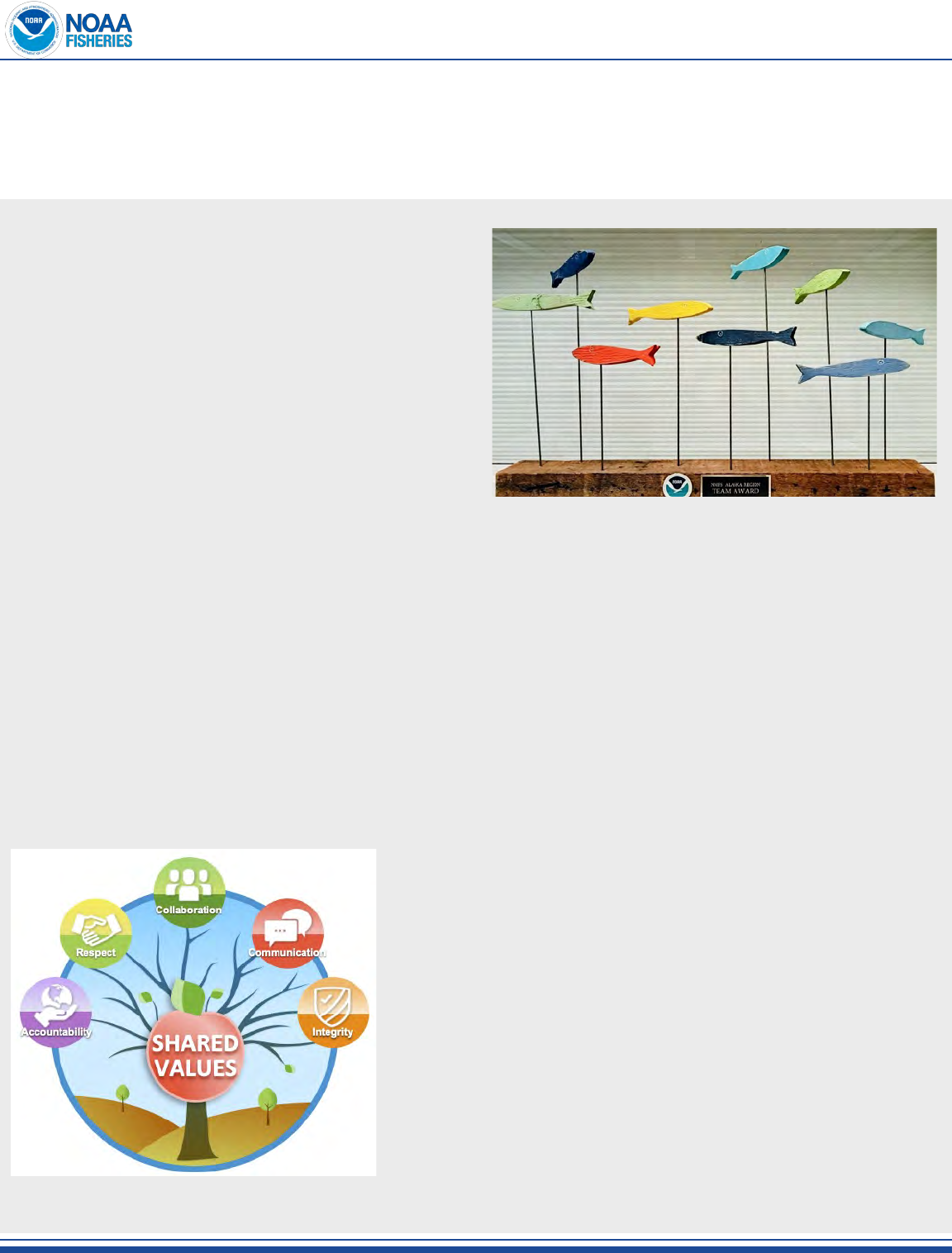
Accomplishments Report // Fiscal Year 2022
11
Goal #6
Improve our organizational excellence and cohesion
by integrating the AKR Shared Values with our work-
place interactions and products.
HCD Awarded Team of the Year
HCD received the Alaska Region’s Team of the Year for our
successful compleon and connued dedicaon to the Team
Development Program (TDP). Alaska Region Senior Leadership
Team (SLT) sponsored HCD to pilot TDP in 2021 to embed the
culture of the AKR Way in the way we work, build capacity
around team eecveness, and promote purposeful individu-
al learning and growth. We engaged in TDP training and acon
-based learning and sustained our momentum in 2022 by inte-
grang the learning in our day to day work with very encour-
aging results. Jodi Pirtle was instrumental in making this train-
ing happen. When training was complete, she created the
HCD Team Development Toolbox, compiling all the training
tools in one place for other Divisions to use. She then transferred
the TDP to the organizaon with an SLT workshop, Management
Team presentaon, and OMD consultaon.
Over the past few years, NOAA Fisheries’ AKR has been commied to a Change Strategy that enables us to collecvely trans-
form how we think about our culture, shared values, work norms, and overall performance. As we strive to capitalize on our
strengths, we also recognize the need to build this vision through team-based training and development that will foster beer
relaonships, enhance team working skills, and produce more eecve soluons to meeng organizaonal and divisional
goals. The TDP is a 6-month, high-impact training program designed to provide team members new knowledge, skills, tools,
insights, and experiences to work more eecvely together to deliver enhanced results and mission-performance. The design
of the TDP enabled opportunies for there to be a ‘Leader in every Chair’ - we are all responsible and accountable for co-
creang the team that we want to be.
As team members, each of us has an integral role in co-creang our team’s future. By engaging in the TDP, we empowered sta
to work together and produce high quality results to meet our HCD Goals and enhance mission-performance. Key outcomes of
the TDP for HCD include:
Tools to become a high funconing team:
Empowering individuals to lead
A greater sense of community and job sasfacon
More ecient, innovave, and strategic communicaon in our work
Connued learning and growth as individuals and as a team
Being a team model and providing a pathway for others in NOAA
Since compleng formal training in September 2021, we connue to in-
tegrate our learning in all that we do; innovang, adapng, and growing
as individuals and a collecve team; and celebrang our success! We
look forward to other AKR teams to be inspired and adapt this training in
ways that work for their path to furthering AKR’s organizaonal excel-
lence.
Alaska Region’s Team of the Year award. Photo Credit: Gretchen Har-
rington
Our shared values are essential and guiding principles for
all the work we do. Image Credit: Paul Irvin, NOAA Fish-
eries
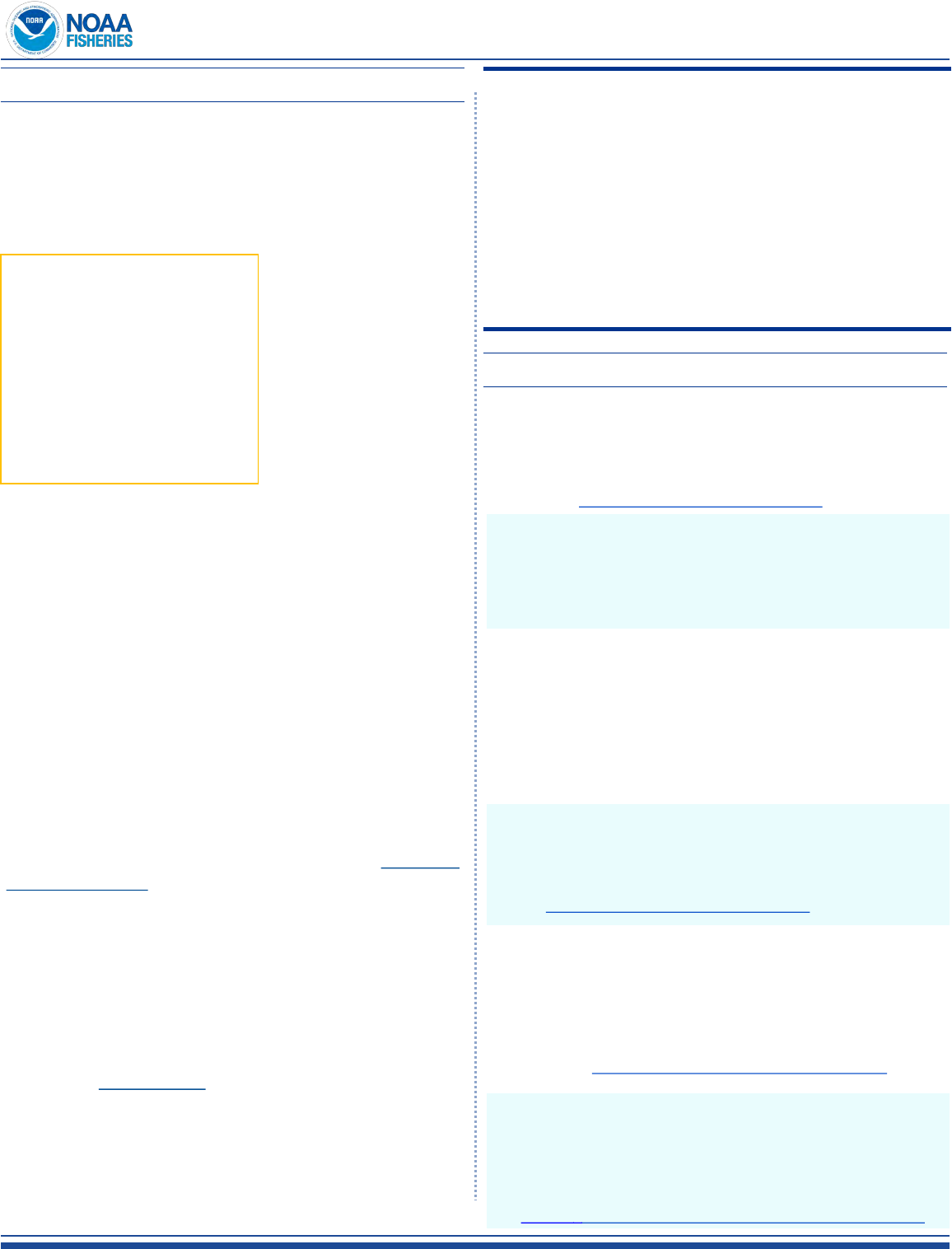
Accomplishments Report // Fiscal Year 2022
OTHER GOAL #6: HCD and The AKR Strategic Plan
It’s All in the Details: From September 2021 to December
2022, Charlene Felkley completed the Strategic Planning Co-
ordinator detail, an assignment that fosters learning culture
through employee development. Assigned to the Regional
Oce and working alongside SLT, she developed a new AKR 5
-year strategic plan that embeds AKR Change Strategy, align-
ing resources with our highest priories. Charlene completed
this detail by providing coordinaon with the strategic plan-
ning contractor, SLT, and many AKR personnel. She convened
several teams to support development of Strategic Plan ob-
jecves, measures and iniaves; reported regularly on the
project and progress through the region’s internal weekly
report, Soundings, intranet page, Directorate meengs, re-
gion-wide Strategy Review Meengs and all-hand meengs;
and created the dashboard to monitor and easily communi-
cate progress of the Strategic Plan.
Charlene volunteered for this opportunity to grow her under-
standing of the AKR’s mission, policies, and the work we do,
develop new skills, and assist in eorts to improve our Strate-
gic Plan. She will bring these experiences and skills back to
HCD, broadening the division as a whole.
Strategic Planning and Collaboraon: The purpose of the
AKR Strategic Plan is to idenfy important areas for improve-
ment based on feedback. Consultaons is an area that has
been idened. Three objecves within the AKR Strategic
Plan direct improvements in how we work together with
those who rely on consultaons to fulll our mission.
HCD and PRD have creat-
ed a steering commiee
to strive toward these
three objecves. Accom-
plishments of this com-
miee and sta include
creang measures to
track progress, creang
the process to gather
input from acon agen-
cies post-consultaon,
increasing our cross-programmac communicaons, increas-
ing our cross-training opportunies, and improving coordina-
on. How HCD and PRD collaborate, share informaon, and
grow with our employees is crically important to reach our
mission.
Jodi Pirtle and Gretchen Harrington are leading two objec-
ves in a cross-divisional eort focused on EBFM and climate
change. This work will enable NMFS AKR to more eecvely
meet EBFM priories and become operaonally adapve and
responsive to management needs regarding climate change
and other global changes.
Publications,
Presentations, and
Outreach
PUBLICATIONS
Barnes, C.L., Essington, T.E., Pirtle, J.L., Rooper, C.N., Laman, E.A.,
Holsman, K.K., Aydin, K.Y., and Thorson, J.T. 2022. Climate-
informed models benet hindcasng but present challenges
when forecasng species–habitat associaons. Ecography:
e06189. hps://doi.org/10.1111/ecog.06189.
W. Morrison, T. L. Rankin, S. A. Oakes, C. J. Harvey, S. Lucey, E.
Keiley, M. Mackey, K. Abrams, and K. Osgood (editors). 2022.
Invesgang and Improving Applicaons of Ecosystem Status
Reports in U.S. Fisheries Management. Report from a 2021
Workshop organized by the Naonal Marine Fisheries Service
Ecosystem-Based Fisheries Management Working Group. U.S.
Dept. of Commerce., NOAA. NOAA Technical Memorandum
NMFS-OSF-11, 44 p.
Shotwell, S.K., Pirtle, J.L., Watson, J.T., Deary, A.L., Doyle, M.J.,
Barbeaux, S.J., Dorn, M.W., Gibson, G.A., Goldstein, E.D.,
Hanselman, D.H. and Hermann, A.J., 2022. Synthesizing inte-
grated ecosystem research to create informed stock-specic
indicators for next generaon stock assessments. Deep Sea
Research Part II: Topical Studies in Oceanography, 198,
p.105070. hps://doi.org/10.1016/j.dsr2.2022.105070
“PRD and HCD have created a
great working group to improve
processes. Improvements we are
making will ripple through and
enhance communication and
relationships with action
agencies.”
-Bonnie Easley-Appleyard, PRD
Lawrence, D.J., Mills, K.E., Morrison, W., Peterson, J.O. and
Porath, M.T., 2022. Ecological and social strategies for man-
aging fisheries using the Resist‐Accept‐Direct (RAD) frame-
work. Fisheries Management and Ecology.
https://onlinelibrary.wiley.com/doi/pdf/10.1111/fme.12545
Lynch, A.J., Rahel, F.J., Limpinsel, D., Sethi, S.A., Engman, A.C.,
M., Limpinsel, D., Magill, R.T., Magness, D.R., Melvin, T.A.,
Newman, R.A. and Porath, M.T., 2022. RAD adapve manage-
ment for transforming ecosystems. BioScience, 72(1), pp.45-
56. hps://doi.org/10.1093/biosci/biab091
Lynch, A.J., Thompson, L.M., Morton, J.M., Beever, E.A., Cliord,
ing science through shared values, goals, and stories: An evi-
dence-based approach to making science maer. Human-
Wildlife Interactions 15(3), Article 27. DOI: https://
doi.org/10.26077/9wss-av78
Merkle, BG, Valdez-Ward, E, Shukla, P, and SR Bayer. 2022. Shar-
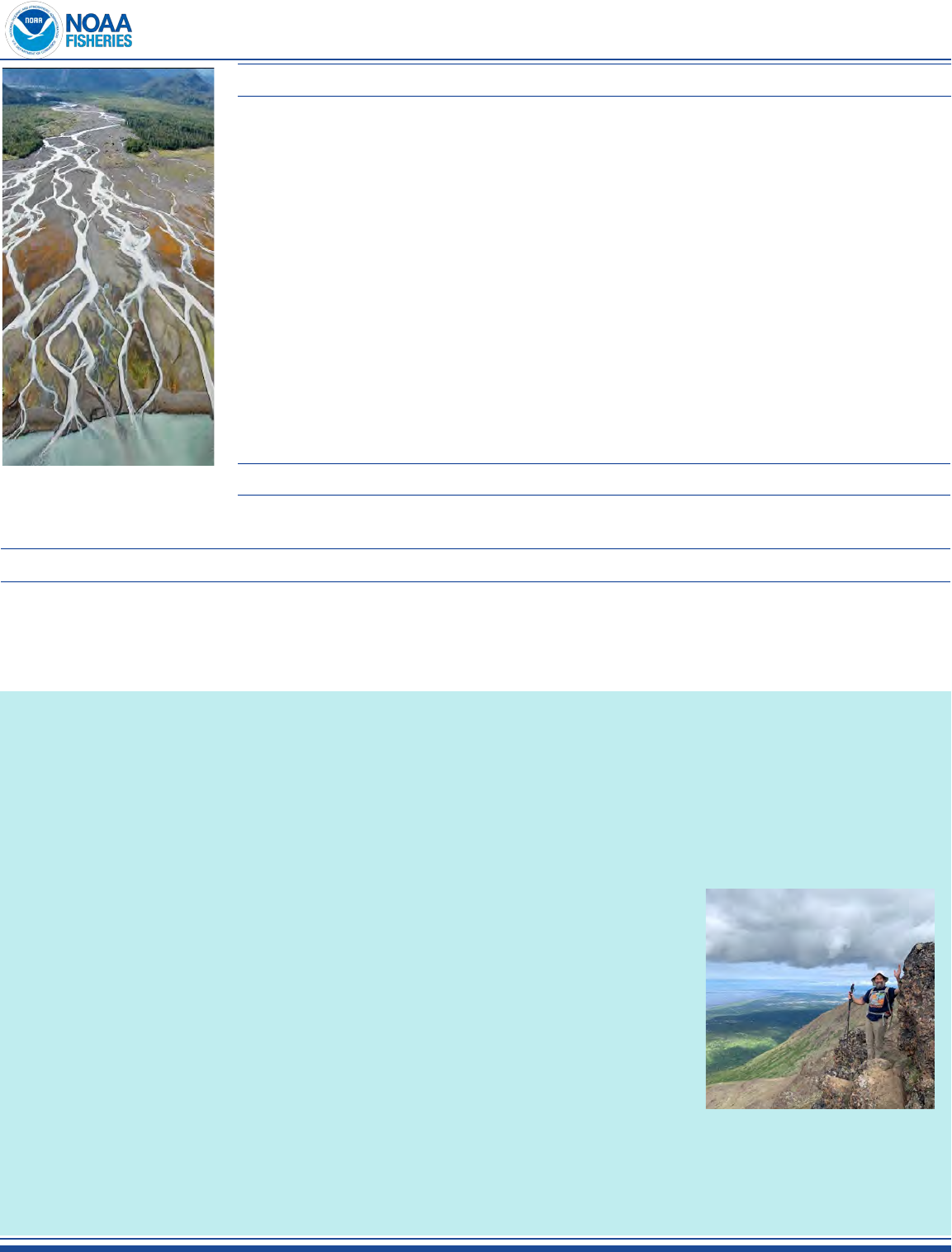
Accomplishments Report // Fiscal Year 2022
13
Aerial view of streams in wetland
with forests and mountains. Pho-
to Credit: Alaska Shorezone
American Fisheries Society Conference – Ellen Ward – Migang Climate Change
NOAA Fisheries Symposium - Sean Eagen & Alisha Falberg – Hydropower Policy and Legal
Southeast Alaska Fish Habitat Partnership - Molly Zaleiski – EFH recommendaons
Joint Groundsh Plan Team (Sept 2022) - Molly Zaleski – Fishing Eects (FE)
Crab Plan Team (Jan 2022, Sept 2022) - Molly Zaleski – FE
Ecosystem Commiee (Jan 2022) - Jodi Pirtle - EFH Descripons and Maps - Molly Zaleski - FE
Scienc and Stascal Commiee (Feb 2022) - Jodi Pirtle - EFH Descripons and Maps - Molly Zaleski -
FE
Denali Commission Funders Coordinaon Meeng – Gretchen Harrington – EFH Consultaon
Western Regional Panel on Aquac Invasive Species Annual Meeng - Linda Shaw - Invasive Green Crab
Discovery and Response
Evidence of Change in Alaska’s Marine Ecosystems and Fisheries (Feb 2022) - Doug Limpinsel - Non-
shing Eects
Joint Groundsh Plan Teams (Nov 2021) - Jodi Pirtle - EFH Descripons and Maps and EFH 5-year Review
overview
Mariculture Conference – Ashley Bolwerk, Linda Shaw, & Molly Zaleski – EFH Recommendaons for Kelp
& Shellsh Farmers
Sean Eagan Parting Thoughts
Sean Eagan joined AKR HCD in 2015 as a hydrologist evaluang the eects of hydropower facilies and mining development on sheries and
habitat, leading the environmental review for several prominent acons in the region. Through his 31 years in Federal service, Sean has
worked for the USFSA and NPS in places like Bryce Canyon, Yosemite, Lassen Volcanic Naonal Park, and American Samoa. Trained in forest-
ry and hydrology, Sean has been a tree climber, trail crew, bio technician, park interpreter, and sta supervisor. He’s protected prairie dogs,
managed prescribed burns, and baled invasive starsh. Sean recently accepted a job at Glacier Bay Naonal Park. We were grateful to
have worked with him and his robust mixture of experience, technical skill, and energec personality. Below are some parng thoughts.
What are the important takeaways about hydropower and habitat that you'd like to share? Hydro-
power can help us migate climate change. With careful planning, eects on salmon can be greatly
diminished at most locaons. Tidal energy has amazing potenal, and it would be great for NMFS to
help advance the understanding of eects. Tackling this amazing source of energy will include ac-
cepng some risks concerning our sh and marine mammals. Also, good working relaonships with
the ulies allows us to protect anadromous sh. While ulies are tasked to provide reasonable
cost energy to Alaskans, every person I worked with also cares about salmon. We should never imply
that they don’t care. Climate change is currently changing the intensity of storms and changing the
norm. We need to remind ulies to design hydropower facilies for storms that will come and future
condions.
You've had a long and interesng career in Federal service. What is the most important thing you learned along the way? There are many
federal and state agencies working to protect the resources. Fighng among agencies is counter producve. We need to avoid it.
What do you love about Alaska? I love all the wild lands where you can go all day without seeing anyone. There are enough adventures
in Alaska for many, many lifemes.
PRESENTATIONS
POSTERS
TRAININGS & WORKSHOPS
Culverts and Bridges Training – Sean Eagan & Erika Ammann – Stream Crossings for Ecological Funcon
Federal Powers Act Training – Sean Eagan – Anadromous Fish Passage
Alaska Invasive Species Partnership Workshop - Linda Shaw & Taylor Stumpf MIC DFW - Invasive Green Crab Discovery and Response
Approaches to Adapng to Alaska’s Rapidly Warming Climate - Doug Limpinsel - Non-shing Eects
